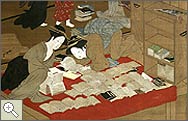
Clothing
Today most Japanese wear Western-style clothing but may choose the traditional kimono for special occasions. The kimono is a floor-length robe held together by a sash at the waist. Men's sashes are narrow, women's sashes, called obi, are wide. For formal occasions, men wear kimonos in dark shades and women wear very colorful and beautifully embroidered kimonos. Men sometimes wear wide-legged trousers called hakama under a short kimono. The most formal kimonos are black garments decorated with white miniature family crests (one on the back, one on each of the sleeves, and one on each side of the chest). The crest designs are usually circular or square and are derived from flowers, plants, birds, animals, and many other subjects.
A summer kimono made of light cotton is called yukata. Winter kimonos are woolen. Special socks (tabi), which are divided between the big toe and the rest of the toes, cover the feet. Over the socks go thong-type sandals, which can be worn on either foot.
Adapted from an essay by Nancy Hague Lyons and Sarah Ridley in Japan: Images and Words.
|
 |
 |
 |
 |

Airing Books and Clothes: By Katssukawa Shunsho
|
 |
 |

Edo period, eighteenth century
Color and gold on silk
Freer Gallery of Art
accession number 05.309
157.1 x 82.6 cm
(60 7/8 "x 32 1/2")
|
 |
 |
 |
|

